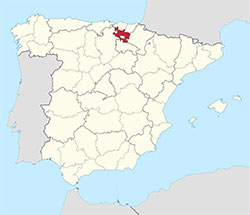Vitoria in Álava

Vitoria is the capital of the province of Álava in the Basque Country. Like all Basque places it also has a name in Euskara, the Basque language: Gasteiz. Its official name is Vitoria-Gasteiz. Vitoria-Gasteiz is also considered the ‘de facto’ capital of the whole Basque region because all the government offices and institutions are there, although its status as capital has never been officially or legally confirmed.
Álava is the Spanish province with the highest population concentration in its capital. The total population is 325,000, and of this 260,000 live in Vitoria or the immediate surrounding area. Vitoria lies at 539 meters above sea level and is surrounded on all sides by mountains. In spite of this it has since Roman times been an important strategic point with some of the main travel routes crossing the city. It covers an area of 276.08 km2.
The climate in Vitoria is very similar to that of the centre of the peninsula with warm summers and cold winters. The average maximum temperature in summer has gone up over the last few years, but used to lie in the mid 20s, even in July and August. In autumn and winter temperatures frequently fall to well below zero. The sun shines just under 2,000 hours a year, and there is usually snowfall in winter.
 Up until the middle of the last century, Vitoria was a small city with the main occupations being commerce and administration. However, in the 1950s a massive industrialization took place converting the small, traditionally conservative city into a large, progressive melting pot of old inhabitants and immigrant workers.
Up until the middle of the last century, Vitoria was a small city with the main occupations being commerce and administration. However, in the 1950s a massive industrialization took place converting the small, traditionally conservative city into a large, progressive melting pot of old inhabitants and immigrant workers.
In the 1960s Vitoria beat all the records for population growths in Spain almost doubling its population. The population exploded from 52,000 in 1950 to 190,000 in 1980.
The very centre of Vitoria, an almond shaped area on the highest point of the city was originally a defensive bastion against the kings of Navarra and Castillo who both had their eye on Vitoria. A surrounding wall was constructed in 1050-1100, and this area stayed well fortified for centuries until a cholera epidemic forced the population to expand into the surrounding areas.
‘The Medieval Almond’ as it is popularly called, still has lots of medieval buildings, although some areas have been modernized and opened into open spaces surrounded by architectural treasures such as Palacio de Bendaña and Palacio Escoriaza-Esquivel, from the 15th and 16th centuries and Santa María Cathedral. But there are still plenty of narrow winding streets to wander around too. Construction on the Santa María Cathedral, locally known as the Old Cathedral, was started after a fire destroyed the old Santa María church in 1202. The plans for the cathedral changed several over the centuries, and the last modification happened as late as in the 1970s, when it was closed to the public while the gothic windows were made larger purely for aesthetic reasons.
The author, Ken Follett, said after visiting Vitoria that the Santa María Cathedral was one of the world’s three most interesting cathedrals, and indeed, walking through it you peel off layers and layers of time as you see the different influences from a period of many centuries.
Not only the cathedral, but also the whole Medieval Almond shows traces of many architectural influences over the centuries, from gothic and renaissance to neoclassic an romantic. There you will find numerous boutiques, craft and decoration shops, and traditional hotels.
Surrounding it there is a modern metropolis where you’ll find department stores, exclusive jewellery shops, all the big fashion and complementary chains as well as modern bars and restaurants. The best time of year to visit Vitoria is spring and summer when the temperatures are pleasant and there’s not too much rainfall.


